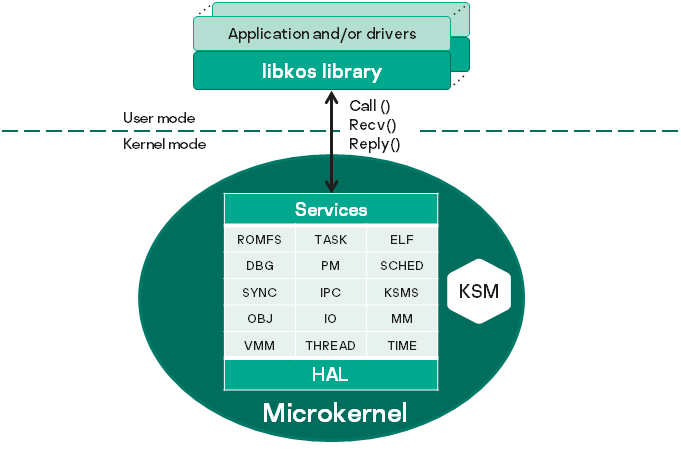KasperskyOS architecture
The KasperskyOS architecture is presented in the figure below:

KasperskyOS architecture
In KasperskyOS, applications and drivers interact with each other and with the kernel by using the libkos library, which provides the interfaces for querying core endpoints. (In KasperskyOS, a driver generally operates with the same level of privileges as the application.) The libkos library queries the kernel by executing only three system calls: Call(), Recv() and Reply(). These calls are implemented by the IPC mechanism. Core endpoints are supported by kernel subsystems whose purposes are presented in the table below. Kernel subsystems interact with hardware through the hardware abstraction layer (HAL), which makes it easier to port KasperskyOS to various platforms.
Kernel subsystems and their purpose
Designation | Name | Purpose |
|---|---|---|
HAL | Hardware abstraction subsystem | Basic hardware support: timers, interrupt controllers, memory management unit (MMU). This subsystem includes UART drivers and low-level means for power management. |
IO | I/O manager | Registration and deallocation of hardware platform resources required for the operation of drivers, such as Interrupt ReQuest (IRQ), Memory-Mapped Input-Output (MMIO), I/O ports, and DMA buffers. If hardware has an input–output memory management unit (IOMMU), this subsystem is used to more reliably guarantee memory allocation. |
MM | Physical memory manager | Allocation and deallocation of physical memory pages, distribution of physically contiguous page areas. |
VMM | Virtual memory manager | Management of physical and virtual memory: reserving, locking, and releasing memory. Working with memory page tables for insulating the address spaces of processes. |
THREAD | Thread manager | Thread management: creating, terminating, suspending, and resuming threads. |
TIME | Real-time clock subsystem | Getting the time and setting the system clock. Using clocks provided by hardware. |
SCHED | Scheduler | Support for three classes of scheduling: real-time threads, general-purpose threads, and IDLE – the state when there is no thread ready for execution. |
SYNC | Synchronization primitive support subsystem | Implementation of basic synchronization primitives: spinlock, mutex, event. The kernel supports only one primitive – futex. All other primitives are implemented based on a futex in the user space. |
IPC | Interprocess communication subsystem | Implementation of a synchronous IPC mechanism based on the rendezvous principle. |
KSMS | Security module interaction subsystem | This subsystem is used for working with the security module. It provides all messages relayed via IPC to the security module so that these messages can be checked. |
OBJ | Object manager | Management of the general behavior of all KasperskyOS resources: tracking their life cycle and assigning unique security IDs (for details, see "Resource Access Control"). This subsystem is closely linked to the capability-based access control mechanism (OCap). |
ROMFS | Immutable file system image startup subsystem | Operations with files from ROMFS: opening and closing, receiving a list of files and their descriptions, and receiving file characteristics (name, size). |
TASK | Process management subsystem | Process management: starting, terminating, suspending and resuming. Receiving the characteristics of running processes (for example, names, paths, and priority) and their exit codes. |
ELF | Executable file loading subsystem | Loading executable ELF files from ROMFS into RAM, parsing headers of ELF files. |
DBG | Debug support subsystem | Debugging mechanism based on GDB (GNU Debugger). The availability of this subsystem in the kernel is optional. |
PM | Power manager | Power management: restart and shutdown. |
